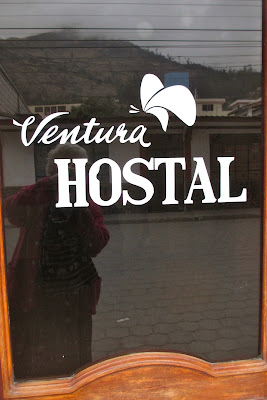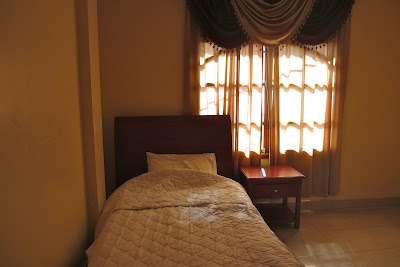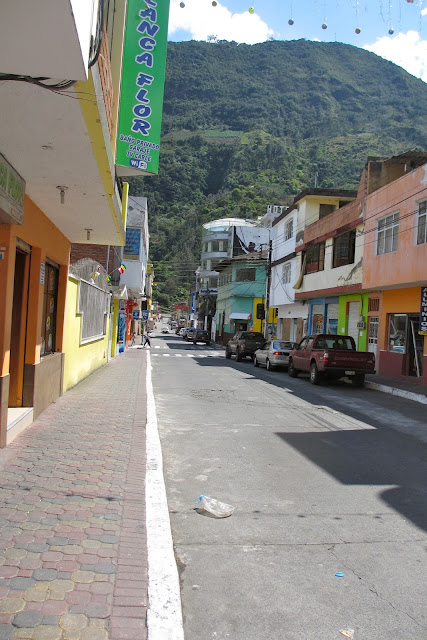Late October I finally decided to go to Alausí and take the famous Nariz del Diablo train ride, even though friends said it was "touristy." I was curious about the town of Alausí, because of hearing of its beauty. In the photo above I'm posing with an adorable child (paid a dollar to his dad) after the train arrived at its destination in Simbambe. The round trip takes about 2 1/2 hours. We left at 8 am.
The train ride worthwhile, I thought, though the $20 cost was a surprise. I paid half the normal cost, due to being over 65 years old. Did everyone else really pay $40? That's hard to believe. Yet the train was packed with passengers. You can read about the train ride at http://www.ecuadorrail.net/ecuador-train-tours/devils-nose.html
But I am getting ahead of myself. I should mention that the bus trip to Alausi from Cuenca takes about 4 hours, and I think I paid $3. Certain times of the day there are buses that go right into town, but I caught a Quito bus and hopped off on the highway outside of Alausí. It only took a few minutes to walk down into the valley where Alausí is located.
Guess I was lucky to get a ticket for the train trip, because I purchased my seat Saturday afternoon before Sunday's trip. The woman who sold me the ticket said there were only 2 seats left. Here she is:
And below are some photos around the train station at Alausí:
I stayed for 2 nights at the Ventura Hostal, and cannot recommend staying here enough. I called the day before my arrival and spoke with Amanda, the Proprietor. We conversed briefly in Spanish and I made reservations for both Saturday and Sunday Nights.
On arrival to the Hostal, Gladys, the lovely Manager of the Ventura, took me to my room. It was downstairs and I felt concern, thinking it might be noisy. Yet all of the rooms upstairs had been taken. In reality, my room was quiet, and I slept comfortably. The Ventura Hostal is only 2 blocks from the Nariz del Diablo train station and I walked there easily in the morning.
The cost for the room does not include breakfast, but I was served (instant coffee and steamed milk, eggs and bread for a minimal cost in the hostal restaurant. The restaurant is very good, and the almuerzo excellent, as well as inexpensive. The service is outstanding and patrons very friendly.
The 2nd night of my stay I moved upstairs due to problems with the WIFI downstairs. It was Sunday and the other guests were gone, so upstairs rooms were available. The rooms upstairs are lovely and once again, all was quiet. There was plenty of hot water. The hostel is freshly painted with a lovely ambience. I paid $15 night because of staying 2 nights. The cost of $30 seemed very fair.
The Ventura has a lovely ambience, and I enjoyed the attention to detail.
I'd recommend the Ventura Hostal to anyone planning a trip on the Nariz del Diablo train. Gladys and Amanda are next.
The photo below was taken shortly before dusk so it's a bit dark. I'm including it because it shows the statue of St. Peter, Patron Saint of Alausí, in the background.
Now, more about the Nariz del Diablo train ride. Below are photos taken the morning of my trip.
You can see train tracks below, as well as the river.
As you can see parts of our route were very beautiful.
Our lovely Tour Guide is next.
Some of the mountains along the train route were very dry.
Many of those on the train trip were Ecuadorian, or from other countries in Latin America. Also, there were travelers from Europe and the United States.
I made friends with a young man from Colombia, ZRadamir, seen next. We took pictures of each other and he brightened my day considerably.
There's a museum at Silbambe, where the train stops, and we enjoyed an hour's break.
And there is a café near the museum. I took a photo of the train station below.
Dancers were performing at the train station.
Next we prepare to board for the trip back to Alausi.
Back in Alausí, I walked to the market and did some sight seeing. Monday morning I boarded the bus, left Alausí (sob), and headed north for Latacunga. As you can see, Central Ecuador is beautiful.
Latacunga is a much bigger city than I anticipated. I want to mention that the bus I was on did not go to the terminal in Latacunga, but dropped us off along the highway. I shared the cost of a taxi with another person into town, for a cost of $3.
I'd reserved a room at the Hostal Tiana. A lot of noisy construction was going on when I arrived. The private room I'd reserved (right over the construction) was priced at $16 and came with a shared bathroom the other side of the hotel. A room with a private bath was available for $25.
Many young backpackers seem to enjoy the ambience at the Hostal Tiana. I felt uncomfortable in the hormonally charged environment and decided this hostal was just not going to work out.
I went to a few other hotels near Parque Vicente Leon in downtown Latacunga. Fortunately I arrived at the Hotel Rosim, where I was shown a very nice room on the 2nd floor. I asked for a reduced rate because of my plan to stay 3 nights, and was charged $13 night. There were 2 beds in the room and one was soft while the other was hard. The firmer bed was fine with me. I slept marvelously well, and cannot say enough how much I appreciated the quiet.
Also, the hotel restaurant is excellent. Vicente, the head waiter, is a delightfully considerate man. And Elizabeth, who served breakfasts, provided excellent recommendations for a day trip to Baños. Breakfasts were not included in the price of the room, but for $3, bread, ham, juice, coffee with steamed milk and an egg were provided. Dinners were wonderful although they were priced a bit high, starting around $8. Below the Uruguayan owner and his wife are conferring.
This dinner of grilled corvina (sea bass) with plantain and salad was delicious at $9.
Vicente, head chef, is next.
Below are Head Chef Vincente, the Hotel owner, and his Son:
The WIFI was iffy, although Olivia, at the front desk, tried her best to refresh the modem. A map of Latacunga and the surrounding area is the only thing I would have liked that the hotel did not provide. The young receptionist was unable to locate a map to provide guests.
All in all, I was thrilled with my experience at the Hotel Rosim. I looked at rooms in 3 neighboring hotels and there is no doubt that the Hotel Rosim offers the best quality for the price.
My 3rd evening in Latacunga, a large group of young athletes from Quito (there must have been 50 of them) came to town and participated in a weight-lifting competition Thursday morning. They filled the dining room Wednesday night and the next morning, as well. The hotel and restaurant staff accommodated all cheerfully and efficiently.
And the youth were surprisingly well mannered. After 10 pm I never heard a peep from their rooms, and slept peacefully the whole night through. They were an inspiration.
Next are photos of the beautiful Parque Vicente Leon in downtown Latacunga.
The big adenture for Tuesday was Quilotoa Lake. Quilotoa is a water-filled caldera and the most western volcano in the Ecuadorian Andes. It is increasingly popular as a tourist destination. The closest town in Zumbuhua, and one may take a bus there and then a truck to the Lake.
The bus we took dropped us off right outside Quilotoa Lake. There are a number of small restaurants and simple hostels in the area. The lake owes its beautiful green color to dissolved minerals, and there are hot springs on the East Side of the Lake. It takes less than an hour to hike down to the lake; however the hike back up is quite a lot more difficult and time consuming.
I walked to the Latacunga Terminal and the bus to Laguna de Quilotoa left at 10 am. Below is a photo of the Bus Stop at Latacunga.
From the bus stop we walked through town and to the viewpoints where the Lake lay shimmering below:
I hiked with some lovely young women from Germany, and a beautiful Brazilian woman, who took this photo.
I enjoyed almuerzo at this restaurant, where a young woman from Uruguay took my order. She was terrific. I remember being surrounded by groups of young German men. I didn't say anything to them; they seem self-absorbed. I am always impressed however, because they speak Spanish beautifully. European youth seem better educated than Americans.
It takes 3-5 days to walk the Quilotoa Loop, which provides the opportunity to stop at Indigenous villages to observe the daily living routines of the locals.
The bus terminal in Baños is opposite the Puente Colgante San Francisco, which is the bridge from which youth can be observed bungee jumping.
I enjoyed watching as a young Uruguayan prepared to bungee jump from the bridge. Later, the man who prepared him spoke for a while, saying that sometimes jumpers lapse into tears of terror and don't make it. The young man who we watched shouted with joy after he jumped.
We watched him swinging below the bridge. He was finally lowered to the ground and walked back up to the bridge, where his companions waited for him.
Next, for some calm after all of the excitement of witnessing bungee jumping off of the bridge, I strolled through the beautiful Parque Palomino Flores, in the center of Baños.
Next is a photo of a map of Baños, in front of the Tourist office there.
Baños is a beautiful town nestled in a valley surrounded by waterfalls and the thermal springs for which it is known. I enjoyed a delightful almuerzo on a balcony overlooking this street. The restaurant was named La Casa de la Abuela.
The people at the next table were Ecuadorians, who lived in Chandler, Arizona, and were visiting Ecuador. They've lived in the United States for 28 years. They said they used to live in New Jersey but prefer living in Arizona.
After visiting the basilica, I walked up the street to the thermal baths. But they are closed afternoons and reopen in the early evening. So I caught a cab to the Termos el Salado, on the other side of Baños. From here on out there are no more photos because my camera's battery needed recharging.
Suffice it to say that I inadvertently went to the best hot baths in Baños, and the cab drive (cost was $1.50) to get there was exquisitely beautiful. The Termos el Salado was very well organized, and the staff and patrons remarkably cordial. Bathing caps (which are mandatory) were available to rent for 50 cents. Because of being over 65 years, I paid an entrance fee of just $1.50.
I was so well taken care of. We were given baskets in which to place our clothes, and a person sat at a desk who put guests' belongings in assigned lockers. We were asked to shower before getting into the thermal baths. The shower water, from the thermal baths, ran continuously. There was a hot pool, several warm pools (where the children tended to linger) and a cold pool big enough in which one could swim laps. I went back and forth between the hot pool and the cold one.
Some guests went swimming under the waterfalls. All were very gracious. The people I spoke with were from Ambato, Quito and different parts of Ecuador visiting Baños on holiday. One couple I met was from Israel, and had just come to Baños for several days after a vacation in the Galapagos.
That evening I returned to Latacunga for my last night there, and the next day caught a bus to Ambato. Then I took another bus to Riobamba. The bus rides were just gorgeous, and I especially enjoyed the splendid views of a snow topped Mt. Chimborazo.
One of the best things about traveling on my own is the opportunity to meet people. At one stop, an indigenous woman who had just been to the market to sell the sheep she raised sat next to me. Her husband sat on the opposite side of the aisle.
The woman told me they went to the market in 2 different towns every week to sell their sheep. In this manner they were able to provide for their 4 children. The lovely young mother told me that the hardest thing about raising children is the cost for their schooling.
Her skin was the beautiful rosy olive tone of indigenous people. Her face shone with beauty. She and her husband bantered together in Quechua, but the two of us spoke in Spanish. The husband's laughter came easily, and the couple seemed very much in love. They brought such a feeling of freshness and connection to the earth with them.
Upon arrival in Riobamba, I ate lunch at a delightful restaurant several blocks down the street from the bus terminal. There were the usual dives and I just walked a little further, where I happened on this gem on a main street of Riobamba. Ecuador is full of surprises like this.
Never have I been served by a more dignified waitress, or been surrounded by better dressed patrons. And the almuerzo, which was delicious, cost just $3.00.
The main street of Riobamba, at least the one closest to the bus terminal. The bus terminal is on the left, barely visible in this photograph.One Thursday morning, I stumbled out the front door right into the 3 de Noviembre parade! The following are just a few photos of that event. Staying in El Centro reminds me of my years living in the French Quarter of New Orleans. One never knows what celebration they are going to be in the middle of, and without making the least effort to be there.
So, that's all for now. I appreciate your time reading my blog update and viewing the photos. There were more activities I wanted to cover, including photos of several evenings at the Ballet Folklorico. Indigenous dance groups from Ecuador, Peru, and Colombia performed at this stellar event.
Also, the Russian Circus came to town, and I thrilled at their performance, as did the thousands of Ecuadorians who took part in it. You gotta love the athleticism, skill & humor of young Russians.
Enough is enough, however, so again, thanks for stopping by and having a look at this blog update; I'll post more in another month or so!



















































































